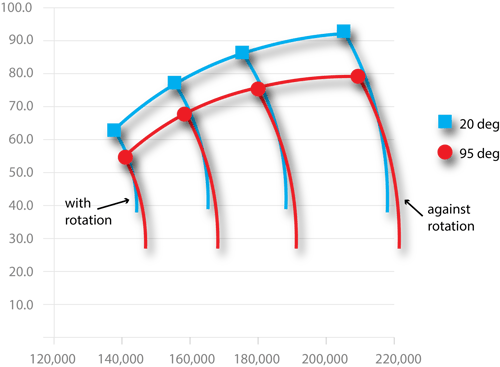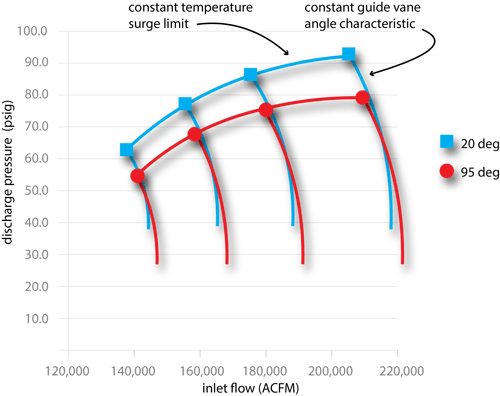The common technique for controlling throughput of an axial compressor is to incorporate variable inlet guide vanes for the first few rows of blades. Some manufacturers can vary all the inlet guide vanes. This method is more efficient than using a suction throttle valve. Due to the very high flow rates of axial compressors, a suction throttle valve would need to be 2 meters or more in diameter and would impose extreme lengths of inlet piping to assure clean streamlines for the inlet flow.
Variable inlet guide vanes are more efficient than throttling because they don’t control the throughput by dissipating excess pressure. Rather, by re positioning the angle of the inlet guide vanes, the head produced by that row of blades is increased or reduced. If the guide vane turns the flow in the direction of the rotating blade, that row of blades will produce less head. Conversely, by turning the flow into the direction of the blade rotation, the head is increased. Effectively, when the position of the variable inlet guide vanes is changed, the characteristic curve of the compressor is changed.
The conventional technique of predicting the surge line by comparing the discharge pressure to the differential pressure across the compressor suction bell is not adequate for an axial compressor if the inlet guide vanes are not fixed. This added variable must be accommodated in order to accurately predict the location of the compressor surge line.

Figure 1 – when the inlet guide vanes are in their normal position, the velocity vector of the gas entering the rotating blade passage is turned into the rotation of the blades. This gives the rotating blades a good “bite” of the gas, allowing them to impart energy into the gas. If the inlet guides are twisted about their axis in such a way that gas velocity vector is more in the direction of the rotation of the rotor, the energy imparted to the gas will be less.

Figure 2– Typical performance map for an axial compressor with variable inlet guide vanes. The adjustment of the inlet guide vane angle will increase or decrease the compressor throughput by changing the head produced by the compressor.
The conventional surge prediction technique can be modified by monitoring the angle of the guide vanes and interpolating the surge line based on the predicted or tested surge lines for various guide vane angles. This technique provides accurate surge line prediction for all operating conditions. The primary disadvantage of incorporating the guide vane angle into the prediction algorithm is the source of the guide vane position value. If the guide vane positioner does not include position feedback, the command to the positioner must be used for the surge line prediction algorithm. And, even if a position feedback signal is available, this signal can be unreliable. For a critical service machine such as the regeneration air blower in an FCCU, instrumentation that cannot be serviced online or supplied in redundant configurations is undesirable.

Figure 3 –Since the head‐capacity characteristic changes with different inlet guide vane angles, the tradition technique of predicting the surge line using discharge pressure and flow is inadequate for this type of compressor.
An alternate technique for predicting the surge line for an air compressor with variable inlet guide vanes is to modify the surge line based on the suction temperature. Effectively, the multiple inlet temperature performance maps provided by the compressor manufacturer are modeled in the compressor control program. The inlet
temperature is measured and an interpolation is performed to calculate the location of the surge line. For a clean compressor, this technique closely follows the results yielded by the guide vane position algorithm. The primary disadvantage of this method is that it requires a little more safety margin to protect the machine as the blades become fouled. A comparison alarm can be included based on the guide vane angle to alert the operator when there is significant deviation between the two algorithms.
The primary benefit of the temperature compensated prediction algorithm is that it relies on conventional instrumentation. Maintenance of a temperature transmitter is much simpler for plant personnel and redundancy schemes are also possible (and recommended for critical machines).

